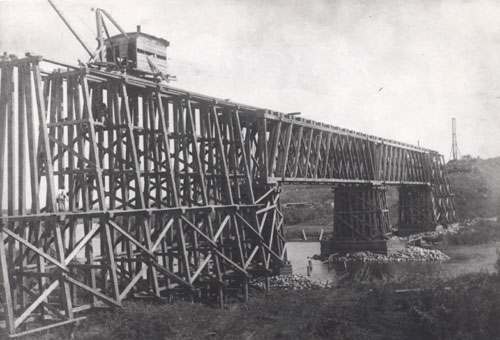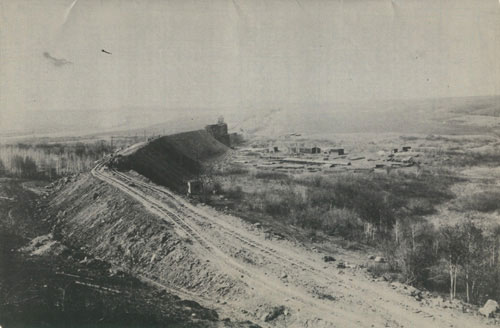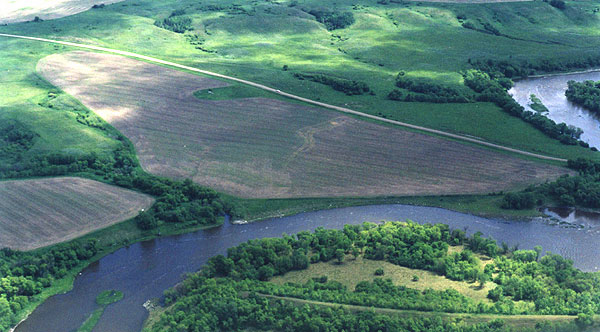

10: Where is Bunclody?

I’m pretty sure that the first time I ever heard of
Bunclody, someone
was making fun of the name. It was Vince Dodds, the morning man on our
local (Brandon) radio station, and he had a running bit involving
checking in on the exploits of the Bunclody Bridge Marching Band.
Something like that, a gentle comment about small town life at a time
when small towns were rapidly disappearing. It's a pleasant name, Irish
in origin, and, yes, perhaps a bit fanciful when compared to the nearby
communities - with their bland, sensible names like Hayfield, Carroll,
or Brandon.
In any
case, the name must have impressed me enough to remember it, but
not enough to prompt a visit for many years.
It
wasn’t until decades later while scouting canoe trips on the Souris
River that I made my first visit. Bridges are all-important when
planning paddling day trips, that's where one finds the most
user-friendly access to the river, and I soon became acquainted with
all such points in western Manitoba.
What a
treat it was to finally see the place. Yes, you could see why
the radio jokester had singled it out. By the sixties many former
prairie villages were that in name only. It was as if we were reluctant
to take down the road signs, change the road maps and admit defeat.
Bunclody turned out to be just a shady roadside park nestled alongside
a gravel road near the river where it brushed against the southern rim
of a wide valley. It barely qualified as a ghost town! At first glance
only the two cairns in the park, and one residence across from it, gave
evidence of any habitation, past or present.
It's
funny how you can miss things, and odd that in driving through the
valley I didn't notice the way the road southward up out of the valley
cut through a narrow ridge running along the hillside. Not so odd
perhaps that on several trips up the gentle slope northwards from the
river, I failed to notice the signs of a substantial embankment
approaching the river a kilometres to the east; unmistakable evidence
of a railway line. It's obvious if you know what you're looking for,
but a quite unobtrusive element of the rolling valley landform if you
don't. And its quite understandable that later, as I paddled downstream
from Souris to where our vehicle was waiting by the Bunclody Bridge, I
failed to notice the same embankment curtailed on either side of the
river. The constant erosion of a riverbank over a few decades had
erased much of the evidence.
Can you
spot the rail line embankment, along the centre
of this photo?
Today a
drive from Minto west to Elgin, or north to Boissevain,
essentially through the eastern reaches of the Souris Plains, gives one
an understanding of the term "wide open spaces".
Then,
as now, the traveler new to the area, and on a trek from
Boissevain northwards to Brandon, whether on the rutted ox-cart path
known as the Heaslip Trail, or on the smoothly paved Highway 10, might
be surprised when, out of nowhere, the valley of the Souris River
appears, a kilometer wide / 70 metre deep channel cut over ten thousand
years ago as the last of the glacial lakes drained.
Scenic
it may well be, but to the railroad builder it holds no romantic
charms. It is an obstacle to be crossed. A challenge perhaps, a
nuisance, definitely.
When
building a railway over hills or through valleys it is often
advisable to the travel a few extra kilometers to avoid a steep grade
and the expensive construction costs associated with difficult terrain.
Trains don't do well on hills, and keeping the grade or slope of the
track as gentle as possible is a priority in construction. As far as
the prairies go, the northern portion of the Souris River valley is a
major challenge.
In 1904
and 1905 the Great Northern survey crews were at work surveying
a railroad from St. John’s N.D. to Brandon Manitoba.
They
rejected a crossing straight south of Minto (where Highway#10 runs
today) as at that point the valley is both deep and wide. Instead they
selected a site a bit upstream where the southern lip of the valley,
although steep, brushed right up against the stream, while the gentle
slope on the north side could be crossed with a modest embankment. To
get there, the line bends westward as it approached the Souris and
follows the curve of the river.
The
elevator and station established on the south side of the river was
called Bunclody, a name already in use for a nearby school and Post
Office.
The
community had its beginning when George McGill and James Copeland
settled with their families along the banks of the Souris River in
1881,
A
school was built in 1884 and George McGill, the Secretary-Treasurer
was given the privilege of naming the school. He chose the name of the
district he left in Ireland.
The
first church services in the Bunclody district were held in 1883 in
the home of Mr. James Copeland and later moved to the school in 1886
and held there until the church was built in 1908.
Crossing
the river was a necessity, and there were three ferries in
operation in the 1880's. The Osborn Ferry near the settlement, the
McGill Ferry was three kilometres upstream and Shepherd's Ferry, not
far from where Highway #10 crosses river now.
In 1893
a pile bridge was built and in 1902 the river was very high and
all the bridges from Souris to Wawanesa were taken out with the ice
flow in the spring.
In 1903
the first span bridge was and that served until 1937.
That
was Bunclody in 1905, a community, but not a village. It was the
decision by the Great Northern Railway, a giant U.S. corporation, to
build a line into Canada that put Bunclody on the map.
A
Big
Project
The
river crossing made Bunclody the major construction site of the
whole project. Three work camps were quickly set up, one at the deep
ravine three kilometres south of the crossing, one at the town site on
the south side of the river where the station house was built, and one
on the north side of the river. Each camp had a steam shovel, modern
technology not available a mere 25 years earlier when the CPR crossed
Manitoba. Dinky engines were used to haul and dump cars as the grade
was built up. It was a major engineering project undertaken by one of
the largest America railroad.
The
ravines south of the river were crossed by building temporary
trestles and dumping fill to create a road-level earthen dam, complete
with huge pipes designed to let the runoff through. The pipes soon
broke and had to be replaced with concrete tunnels two metres square -
still quite visible today, although somewhat clogged with rubble. One
resident told me about boyhood adventures that included a dare to go
through the tunnel.
The
bridge over the Souris was 132 metres long and 26 metres high.
Timber for the trestles, including 30 metre long cedar pilings had to
be hauled from the CN Rail stop at Carroll, about eight kilometres away.
The
elevator and station, along with a bunkhouse for some of the many
full time employees required to maintain the line, were situated
halfway up the southern ridge of the valley, half a kilometer from the
bridge. The water tank was on the far side of the river slightly north
of the bridge, with pumps and pipes to draw river water for the steam
engines.
 Crossing
the Souris at Bunclody
Crossing
the Souris at Bunclody
 Preparing
the grade towards the crossing of the Souris near Bunclody.
Preparing
the grade towards the crossing of the Souris near Bunclody.
Today,
standing on the old rail line where it abruptly ends atop a
steep cliff at the river's edge, having followed it from that site
through a pasture as it curved towards the former crossing, one can
look northward across the river and see one of the few remaining
obvious signs of the old line. Directly below you, in the centre of the
river is a small gravel bar, once the base of the central bridge
support, and across the river where the valley wall slopes gently away
from the water's edge, is the high embankment built to carry the line
gently across the wide valley.
Bunclody
never became a very big village, but it did become a busy
place – for a while.
From
the day that first train came through on June of 1906, there were
two passenger trains per day, going south at 8 a.m. and north at 7
p.m., six days a week. The freight train ran every day, south on one
day, north the next, except Sunday.

The
abandoned rail bed and the foundation of the bridge were readily
visible from the air in 2001.
The worst spot was the Wilson Cut two kilometres north of
Heaslip, the
site of an adventure in March of 1923. A train with two engines and a
snowplow was stuck and snow drifted in half-way up the windows. In such
cases, neighboring farmers were often called upon to help out and the
presumably patient passengers relied on the kindness of strangers
so-to-speak. Supplies were brought from the Heaslip store and lunch was
served.
Spring
runoff also could be a problem when the pipes (culverts) under
ravine embankments couldn't handle the water.
But
other than snowfall, and a few problems with clogged culverts at
spring runoff, very few things interrupted the service. Doctors and
patients relied on it. It evolved from being a novelty to being a
necessity.
The End
of The Line
By late
20's it was apparent that big profits for the company would
never materialize. The line had been built into an area that was
already served by east-west lines. Unlike the original CPR lines, the
owners had been prevented from making large start-up profits from the
establishment of towns and the grants of land often associated with a
new line. With the defeat of Laurier in 1911, the hope of a reciprocity
agreement with the US, which would have increased north-south freight,
was effectively over. The population had reached its peak and the car
was establishing itself as the mode of choice for personal
transportation.
This
possibility of reciprocity had encouraged the expansion of the
Great Northern and some speculated that it would lead to a large
portion of the grain harvest being transported through the U.S.
Needless to say, there were many Canadians opposed to reciprocity for
that very reason. The Portage La Prairie Weekly noted that “The Great
Northern Railway…has no less than seventeen different lines operating
between Canada and the country over the border…: and could see that
much business would go that way. “ 1 That was a pretty good argument
against Reciprocity from a western point of view.
Another
force at play was the growth of the cooperative initiative that
became the Manitoba Pool Elevators.
"Part
of the problem … was that farmers were prepared to support the
Manitoba Pool, even at a financial cost to themselves." McCabe had
monopoly on the GN line, thus there were no Pool Elevators along its
route. At one time Pool was paying 53 per bushel while McCabe as much
as 75. By 1929 losses had mounted to $74000. In 1935 grain
tonnage on the line was only 16.5 % of what it had been in 1913. 2
At the
same time passenger service fell off. Although it was never
intended to be the primary source of income, it was helpful to the
bottom line. In 1906 travel by auto was slow and unreliable. But people
really liked the freedom the car gave them, and better roads along with
cheaper, more reliable vehicles developed rapidly. By 1922 a "highway"
existed from Brandon to Boissevain and on to the border. By 1927 rail
passenger numbers began to decline.
The
depression worsened the situation and only pressure from the
government kept it open until 1936 when the mail contract ended. It was
simply no longer a viable enterprise, if it ever was. The tracks torn
up in 1937 after there were no offer for the purchase of the line. The
company formally continued to exist until Dec. 12. 1963 to allow for
ongoing land transfers.
The
last train ran June 14, 1936. Brandon railway historian Lawrence
Stuckey remembered with apparent fondness the day when he and a friend
waved to the engineer for the last time. 3
So
ended a chapter in the region's transportation history. The line is
credited with ending the rural isolation felt by many Westman settlers
and offered them an important timesaving travel option. Daytime
shopping trips to Brandon were a treat, students at university could
get home for weekends. But the car and the improved road conditions
offered a new sense of freedom to rural residents, and the line, though
remembered fondly by old-timers, was just not needed any longer.
So in a
way the Bunclody story is the story of not one, but two false
starts.
Sources
1.
Portage La Prairie Weekly July 26, 1911
2.
Everitt p84
3.Bain
& Stuckey p14
Todd,
John, Jim Hill’s Canadian Railway, Canadian Rail No. 283, August
1975, Canadian Railroad Historical Association, Montreal
Everitt,
John, Kempthorne, Roberta, Scafer, Charles, Controlled
Aggression: James J. Hill and the Brandon, Saskatchewan and Hudson’s
Bay Railway, Brandon University, 1987,
Rose,
D.F., Bunclody Community, 1879-1970, Bunclody Community, Carroll
MB.,1970
Archival
Bunclody photos were taken by Gilford Copeland and provided by
Alan Rose.
Manitoba
Telegram June 5., 1906
The
Souris River at Bunclody
|